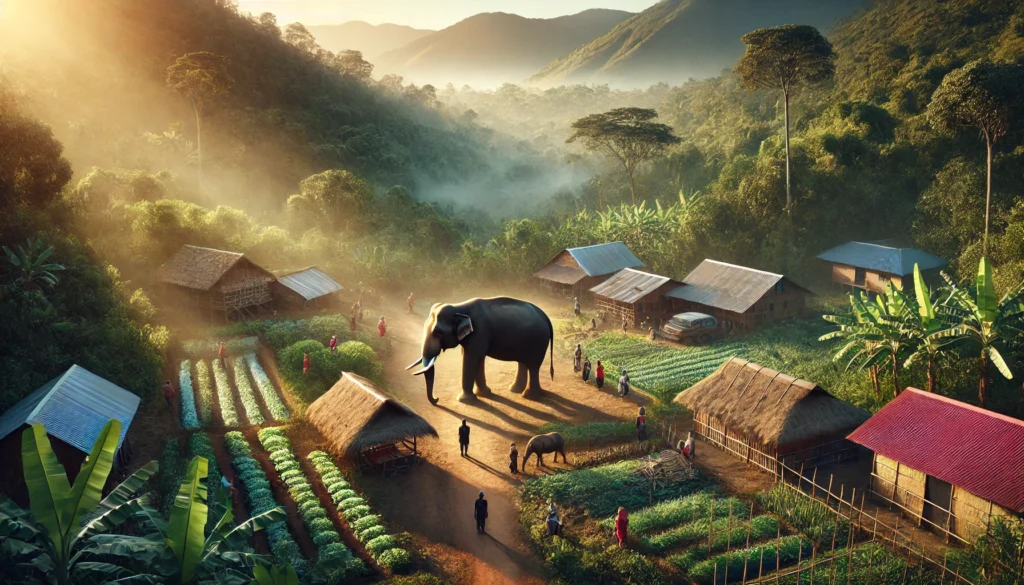Picture this: You’re having a lovely picnic in the park, surrounded by the beauty of nature, when suddenly a raccoon decides your sandwich looks far more appetizing than whatever it usually eats. Or imagine waking up to find that a herd of elephants has decided your crops make for a fantastic midnight snack. Welcome to the world of human-wildlife conflict, where animals become the ultimate party crashers in our human-centric world!
But jokes aside, human-wildlife conflict is a serious issue that’s been growing as fast as our cities and populations. It’s like we’re playing an endless game of Monopoly with animals, and neither side is willing to give up their precious real estate. In this blog, we’ll dive into the challenges we face when our paths cross with our wild neighbors and explore some solutions that don’t involve building a moat around our cities (though I’m sure some people have considered it).
What Exactly is Human-Wildlife Conflict?
When Worlds Collide
Human-wildlife conflict is what happens when animals and humans try to coexist in the same space, often with disastrous results. It’s like trying to fit an elephant into a Smart car – something’s gotta give, and it’s usually not the elephant.
These conflicts can range from minor annoyances, like squirrels raiding bird feeders, to major issues, such as lions attacking livestock or elephants destroying entire fields of crops. It’s a global problem that affects both developed and developing countries, rural and urban areas alike. Basically, anywhere humans and wildlife overlap, there’s potential for conflict.
The root of the problem often lies in habitat loss and fragmentation. As we humans expand our territories, we’re essentially evicting animals from their homes without so much as a “sorry, not sorry.” Imagine if a group of gorillas decided to set up camp in your living room – that’s pretty much how the animals feel when we encroach on their territory.
But it’s not just about territory. Human-wildlife conflicts also arise from competition for resources, changes in animal behavior due to human activities, and sometimes just plain old misunderstandings between species. It’s like a cosmic game of telephone, where what we’re trying to communicate to wildlife gets lost in translation.
The Many Faces of Human-Wildlife Conflict
A Zoo of Problems
Human-wildlife conflict comes in many shapes and sizes, much like the animal kingdom itself. Let’s take a whirlwind tour of some of the most common types of conflicts:
- Crop Raiders: This is where animals decide that farmers’ fields are their personal all-you-can-eat buffets. Elephants in Africa and Asia, wild boars in Europe, and monkeys pretty much everywhere are notorious for this. It’s like they’ve discovered the joys of takeout, except they never pay the bill.
- Livestock Predation: Here, carnivores like wolves, lions, and leopards develop a taste for farm animals. It’s as if they’ve decided to upgrade from the “hunt your own food” plan to the “delivered to your doorstep” option.
- Human-Animal Collisions: This is a fancy way of saying “animals on roads.” From deer in headlights to elephants on highways, it’s a problem that affects both the animals and unfortunate drivers. It’s like a very dangerous game of real-life Frogger.
- Urban Wildlife: As cities expand, some animals decide to become city slickers. Raccoons raiding trash cans, coyotes in suburban backyards, and monkeys stealing food from balconies are all examples of wildlife adapting to urban life – often to the chagrin of human residents.
- Disease Transmission: Sometimes, the conflict is invisible to the naked eye. Zoonotic diseases (those that can pass from animals to humans) are a serious concern. It’s nature’s way of reminding us that we’re all connected, whether we like it or not.
The Fallout: Why Should We Care?
It’s Not Just About Inconvenience
Now, you might be thinking, “So what if a monkey stole my sandwich or a deer dented my car?” But the impacts of human-wildlife conflict go far beyond minor annoyances. Let’s break it down:
- Economic Impacts: For many communities, especially in rural areas, conflicts with wildlife can mean the difference between a good harvest and starvation. Crop damage by elephants in Africa or wild boars in Europe can devastate small farmers. Livestock losses to predators can wipe out a family’s entire wealth in some parts of the world. It’s like nature is playing a very unfair game of Monopoly, and the animals always seem to have the “Get Out of Jail Free” card.
- Conservation Setbacks: When animals damage property or threaten livelihoods, it’s not surprising that some people develop negative attitudes towards wildlife. This can lead to retaliatory killings, which can be devastating for endangered species. It’s a bit like evicting your noisy neighbor, only to realize they were the last of their kind.
- Human Safety: In some cases, conflicts with wildlife can pose serious risks to human safety. Attacks by large predators, encounters with venomous snakes, or diseases transmitted by wildlife can all be life-threatening. It’s as if Mother Nature occasionally forgets that we’re supposed to be at the top of the food chain.
- Psychological Impacts: Living with the constant threat of wildlife conflict can take a toll on mental health. Imagine trying to sleep knowing that an elephant might trample your crops at any moment, or that a tiger could be lurking in the shadows. It’s like living in a perpetual horror movie, except the monsters are real and often endangered.
- Ecosystem Imbalance: When we remove predators or other key species from an ecosystem due to conflicts, it can have far-reaching consequences. It’s like pulling a thread from a tapestry – you might think you’re solving one problem, but you end up unraveling the whole thing.
The Numbers Game: Human-Wildlife Conflict in Facts and Figures
Let’s take a moment to crunch some numbers. After all, nothing says “serious problem” quite like cold, hard stats. Here’s a table that breaks down some key figures related to human-wildlife conflict:
| Fact | Figure | Year |
|---|---|---|
| Annual cost of crop damage by elephants in Africa | $60 million | 2018 |
| Number of people killed by tigers in India | 1,052 | 2012-2019 |
| Livestock killed by wolves in the EU | 21,000 | 2018 |
| Estimated annual cost of wildlife-vehicle collisions in the US | $8 billion | 2019 |
| Number of zoonotic diseases identified | 1,415 | 2020 |
Looking at these numbers, it’s clear that human-wildlife conflict is no laughing matter (even if we’re trying to inject a bit of humor into this blog). It’s a problem that affects millions of people and countless animals worldwide, with significant economic, ecological, and social consequences.
Why is This Happening? The Root Causes
A Perfect Storm of Problems
Understanding why human-wildlife conflict occurs is crucial if we want to find effective solutions. It’s like trying to solve a Rubik’s Cube – you need to understand how all the pieces fit together before you can make any progress. Here are some of the key factors contributing to the increase in human-wildlife conflicts:
- Habitat Loss and Fragmentation: As human populations grow and expand, we’re constantly encroaching on wildlife habitats. Forests are cleared for agriculture, wetlands are drained for development, and suddenly animals find themselves homeless. It’s like a never-ending game of musical chairs, and the animals always seem to be left without a seat when the music stops.
- Human Population Growth: More people means more demand for land and resources. We’re essentially throwing a bigger and bigger party on Earth, but forgetting to send invitations to the other species we share the planet with.
- Climate Change: As temperatures rise and weather patterns shift, both humans and animals are forced to adapt. Sometimes this means moving into new areas, leading to new conflicts. It’s nature’s version of musical homes, and nobody’s quite sure where they’ll end up.
- Changes in Land Use: Converting natural habitats into agricultural land or urban areas disrupts wildlife movement patterns and food sources. Imagine if someone turned your favorite restaurant into a parking lot – you’d probably be pretty upset too.
- Increased Access to Protected Areas: As ecotourism grows and infrastructure improves, humans are venturing into previously remote areas. It’s like we’ve discovered cheat codes to access all areas of the game map, but forgot that there might be high-level bosses (read: dangerous wildlife) waiting for us.
- Declining Natural Prey: When we over-hunt animals or destroy their habitats, predators may turn to livestock as an alternative food source. It’s the animal kingdom equivalent of “if the vending machine is empty, raid the staff fridge instead.”
- Human Behavior: Sometimes, our own actions inadvertently attract wildlife. Improper garbage disposal, feeding wild animals, or leaving pet food outside can all lead to conflicts. It’s like we’re accidentally sending out party invitations to every animal in the neighborhood.
Strategies for Coexistence: Solutions and Success Stories
Making Peace with Our Wild Neighbors
Now that we’ve painted a pretty grim picture, let’s focus on the good news. Humans are nothing if not innovative, and we’ve come up with some pretty clever solutions to human-wildlife conflict. Here are some strategies that are showing promise:
- Physical Barriers: Sometimes, the simplest solutions are the most effective. Fences, especially those incorporating local materials and designs, can be highly effective in keeping wildlife out of crops or livestock areas. In parts of Africa, beehive fences have proven successful in deterring elephants – turns out even elephants aren’t keen on bee stings!
- Compensation Schemes: Many countries have implemented programs to compensate farmers for losses due to wildlife. While not a perfect solution, it can help alleviate the economic burden and reduce retaliatory killings. It’s like wildlife insurance – you hope you never need it, but you’re glad it’s there if you do.
- Alternative Livelihoods: Encouraging communities to develop wildlife-friendly livelihoods, such as ecotourism, can turn animals from pests into valuable assets. It’s about changing the narrative from “that elephant ate my crops” to “that elephant brought tourists who paid for my kids’ education.”
- Improved Waste Management: In urban areas, better garbage disposal systems can reduce conflicts with animals like bears, raccoons, and monkeys. It’s like putting a lock on nature’s cookie jar.
- Wildlife Corridors: Creating protected pathways for animals to move between habitats can reduce their need to venture into human-dominated areas. Think of it as building highway systems for animals – complete with their own rush hours and traffic jams.
- Early Warning Systems: Technology is playing an increasing role in conflict mitigation. SMS alerts about approaching elephants or predators can help communities prepare and avoid confrontations. It’s like having a neighborhood watch program, but for wildlife.
- Education and Awareness: Sometimes, simply understanding wildlife behavior can go a long way in preventing conflicts. Teaching people how to coexist with wildlife, what to do in case of an encounter, and the importance of conservation can make a big difference. It’s like learning to speak “animal” – once you understand them, they’re not so scary anymore.
Case Study: The Lion Guardians of Kenya
From Hunters to Protectors
One inspiring success story comes from the Amboseli region of Kenya, where the Lion Guardians program has transformed the relationship between local Maasai communities and lions. Traditionally, Maasai warriors would hunt lions as a rite of passage and to protect their livestock. This led to a drastic decline in lion populations.
The Lion Guardians program took a novel approach: they recruited young Maasai warriors to become protectors of lions instead of hunters. These guardians use their tracking skills to monitor lion movements, warn communities when lions are nearby, and help farmers improve their livestock protection methods.
The results have been remarkable. Since the program’s inception in 2007, lion populations in the area have rebounded, and retaliatory killings have decreased significantly. It’s a prime example of how traditional knowledge can be combined with conservation goals to create a win-win situation for both humans and wildlife.
The Road Ahead: Challenges and Opportunities
Building Bridges, Not Walls
As we look to the future, it’s clear that human-wildlife conflict will remain a significant challenge. With human populations projected to reach 9.7 billion by 2050, the pressure on wildlife habitats will only increase. However, there are reasons for optimism:
- Technological Advancements: From AI-powered early warning systems to innovative deterrent devices, technology offers new tools for conflict mitigation. Who knows, maybe we’ll soon have universal translators that let us negotiate directly with animals!
- Increased Global Awareness: As more people become aware of the importance of biodiversity and the impacts of human-wildlife conflict, there’s growing support for conservation efforts. It’s like the whole world is slowly becoming one big nature appreciation society.
- Policy Changes: Many countries are implementing more wildlife-friendly policies and land-use planning. It’s a sign that governments are starting to realize that what’s good for wildlife is often good for people too.
- Interdisciplinary Approaches: Recognizing that human-wildlife conflict is a complex issue, researchers and practitioners are increasingly adopting interdisciplinary approaches, combining insights from ecology, social sciences, and local knowledge. It’s like assembling an Avengers team to tackle wildlife conflicts.
Learning to Share Our Planet
As we wrap up this whirlwind tour of human-wildlife conflict, one thing is clear: there’s no simple solution to this complex problem. It’s going to take creativity, compassion, and a whole lot of compromise from both humans and animals (though admittedly, the animals might be a bit harder to negotiate with).
The key lies in finding ways to coexist rather than compete. We need to recognize that we’re not separate from nature, but a part of it. After all, we’re just another species of animal, albeit one with a peculiar fondness for smartphones and avocado toast.
So the next time you find yourself face-to-face with a raccoon raiding your trash can, or hear about elephants crashing a village party, remember: we’re all in this together. With a little understanding, a dash of innovation, and a healthy dose of respect for our wild neighbors, we can turn this conflict into coexistence.
Who knows? Maybe one day we’ll be able to invite bears to our picnics and elephants to our garden parties. Until then, let’s keep working on being better neighbors to our wild friends. After all, they were here first – we’re just the noisy new kids on the block.
Disclaimer: This blog post is based on information available up to 2020. While we strive for accuracy, the field of human-wildlife conflict is constantly evolving. Please consult the latest research and local authorities for the most up-to-date information. If you spot any inaccuracies, please report them so we can correct them promptly. Remember, when it comes to wildlife, it’s always better to be safe than sorry!




